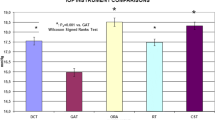Abstract
Background
In an experimental laboratory investigation we compared intraocular pressure (IOP) measurements obtained by dynamic contour tonometry (DCT), Goldmann applanation tonometry (GAT), and pneumatonometry (PTG) with intracameral manometry on human cadaver corneas of different hydration conditions.
Methods
Ten freshly enucleated eyes were de-epithelialized. Two tubes were placed in the anterior chamber in opposite directions and connected to a transducer and to a bottle system filled with balanced salt solution. The pressure in the eye was then adjusted between 5 mmHg and 58 mmHg by electronically altering the height of the bottle. Central corneal thickness (CCT) was registered and IOP measurements were obtained with DCT, GAT, and PTG at each manometric pressure reading. Immediately after the trial the same corneas were artificially dehydrated and the same measurement regimen was repeated.
Results
In the pressure range defined by the bottle height 10–50 cm, IOP values measured by DCT were 0.50 mmHg (95% CI=0.40–0.60) and 0.36 mmHg (95% CI=0.25–0.47) higher than manometric readings before and after dehydration, respectively. GAT showed consistently lower values than manometry, the difference being −3.48 mmHg (95% CI=−3.91 to −3.05) and −3.14 mmHg (95% CI=−3.39 to −2.89), respectively. Similar results were obtained with PGT, namely differences of −4.75 mmHg (95% CI=−5.21 to −4.29) and −3.98 mmHg (95% CI=−4.48 to −3.48) for the hydrated and the dehydrated corneal condition, respectively. Only DCT showed no significant change in accuracy between hydrated and dehydrated corneas.
Conclusions
In this in vitro study DCT values for IOP were significantly closer to the manometric reference pressure than those obtained using GAT and PTG, independent of the state of corneal hydration.






Similar content being viewed by others
References
Brandt JD, Beiser JA, Kass MA, Gordon MO (2001) Central corneal thickness in the ocular hypertension treatment study (OHTS). Ophthalmology 108:1779–1788
Bron AM, Creuzot-Garcher C, Goudeau-Boutillon S, d’Athis P (1999) Falsely elevated intraocular pressure due to increased central corneal thickness. Graefes Arch Clin Exp Ophthalmol 237:220–224
Doughty MJ, Zaman ML (2000) Human corneal thickness and its impact on intraocular pressure measures: a review and meta-analysis approach. Surv Ophthalmol 44:367–408
Duch S, Serra A, Castanera J et al (2001) Tonometry after laser in situ keratomileusis treatment. J Glaucoma 10:261–265
Duffey RJ, Tchah H, Lindstrom RL (1989) Human cadaver corneal thinning for experimental refractive surgery. Refract Corneal Surg 5:41–42
Ehlers N, Bramsen T, Sperling S (1975) Applanation tonometry and central corneal thickness. Acta Ophthalmol (Copenh) 53:34–43
Eisenberg DL, Sherman BG, McKeown CA, Schuman JS (1998) Tonometry in adults and children. A manometric evaluation of pneumatonometry, applanation, and TonoPen in vitro and in vivo. Ophthalmology 105:1173–1181
Feltgen N, Leifert D, Funk J (2001) Correlation between central corneal thickness, applanation tonometry, and direct intracameral IOP readings. Br J Ophthalmol 85:85–87
Goldmann H (1955) Un nouveau tonometre d’applanation. Bull Soc Ophtalmol Fr 67:474–478
Goldmann H, Schmidt T (1957) Ueber Applanationstonometrie. Ophthalmologica 134:221–242
Goldmann H, Schmidt T (1965) On applanation tonography. Ophthalmologica 150:65–75
Goldmann H, Schmidt T (1966) Studien mittels Applanationstonographie. Doc Ophthalmol 20:184–213
Hamaoui M, Tahi H, Chapon P et al (2001) Corneal preparation of eye bank eyes for experimental surgery. Cornea 20:317–320
Johnson M, Kass MA, Moses RA, Grodzki WJ (1978) Increased corneal thickness simulating elevated intraocular pressure. Arch Ophthalmol 96:664–665
Kaufmann C, Bachmann LM, Thiel MA (2003) Intraocular pressure measurements using dynamic contour tonometry after laser in situ keratomileusis. Invest Ophthalmol Vis Sci 44:3790–3794
Kniestedt C, Nee M, Stamper RL (2004) Dynamic contour tonometry. A comparative study on human cadaver eyes. Arch Ophthalmol 122:1287–1293
Langham ME, McCarthy E (1968) A rapid pneumatic applanation tonometer. Comparative findings and evaluation. Arch Ophthalmol 79:389–399
Maloney RK (1990) Effect of corneal hydration and intraocular pressure on keratometric power after experimental radial keratotomy. Ophthalmology 97:927–933
McMillan F, Forster PK (1975) Comparison of MacKay-Marg, Goldmann and Perkins tonometers in abnormal corneas. Arch Ophthalmol 93:420–424
Moses R (1958) The Goldmann applanation tonometer. Am J Ophthalmol 46:865–869
Moses RA, Grodzki WJ (1979) The pneumatonograph. A laboratory study. Arch Ophthalmol 97:547–552
Muller LJ, Pels E, Vrensen GF (2001) The specific architecture of the anterior stroma accounts for maintenance of corneal curvature. Br J Ophthalmol 85:437–443
Shah S, Chatterjee A, Mathai M et al (1999) Relationship between corneal thickness and measured intraocular pressure in a general ophthalmology clinic. Ophthalmology 106:2154–2160
Simon G, Small RH, Ren Q, Parel JM (1993) Effect of corneal hydration on Goldmann applanation tonometry and corneal topography. Refract Corneal Surg 9:110–117
Singh RP, Goldberg I, Graham SL et al (2001) Central corneal thickness, tonometry, and ocular dimensions in glaucoma and ocular hypertension. J Glaucoma 10:206–210
Swinger CA, Kornmehl EW (1985) Dehydration of post-mortem eyes for practice and experimental surgery. Ophthalmic Surg 16:182–183
Terry MA, Ousley PJ, Zjhra ML (1994) Hydration changes in cadaver eyes prepared for practice and experimental surgery. Arch Ophthalmol 112:538–543
Whitacre MM, Stein RA, Hassanein K (1993) The effect of corneal thickness on applanation tonometry. Am J Ophthalmol 115:592–596
Wolfs RC, Klaver CC, Vingerling JR et al (1997) Distribution of central corneal thickness and its association with intraocular pressure: the Rotterdam Study. Am J Ophthalmol 123:767–772
Acknowledgements
Christoph Kniestedt was financially supported by the Swiss National Fund, Berne, Switzerland and the Fund to Prevent and Fight Against Blindness, Zurich, Switzerland. The study itself was also supported by That Man May See Foundation, San Francisco, USA. The authors thank Swiss Microtechnology AG for the experimental dynamic contour tonometer and Alan Bostrom, PhD, from the Department of Biostatistics at UCSF for the statistical analysis. They also thank Robin Troyer for her support in the laboratory and for her coordination with the eye bank centers.
Author information
Authors and Affiliations
Corresponding author
Rights and permissions
About this article
Cite this article
Kniestedt, C., Nee, M. & Stamper, R.L. Accuracy of dynamic contour tonometry compared with applanation tonometry in human cadaver eyes of different hydration states. Graefe's Arch Clin Exp Ophthalmol 243, 359–366 (2005). https://doi.org/10.1007/s00417-004-1024-6
Received:
Revised:
Accepted:
Published:
Issue Date:
DOI: https://doi.org/10.1007/s00417-004-1024-6




